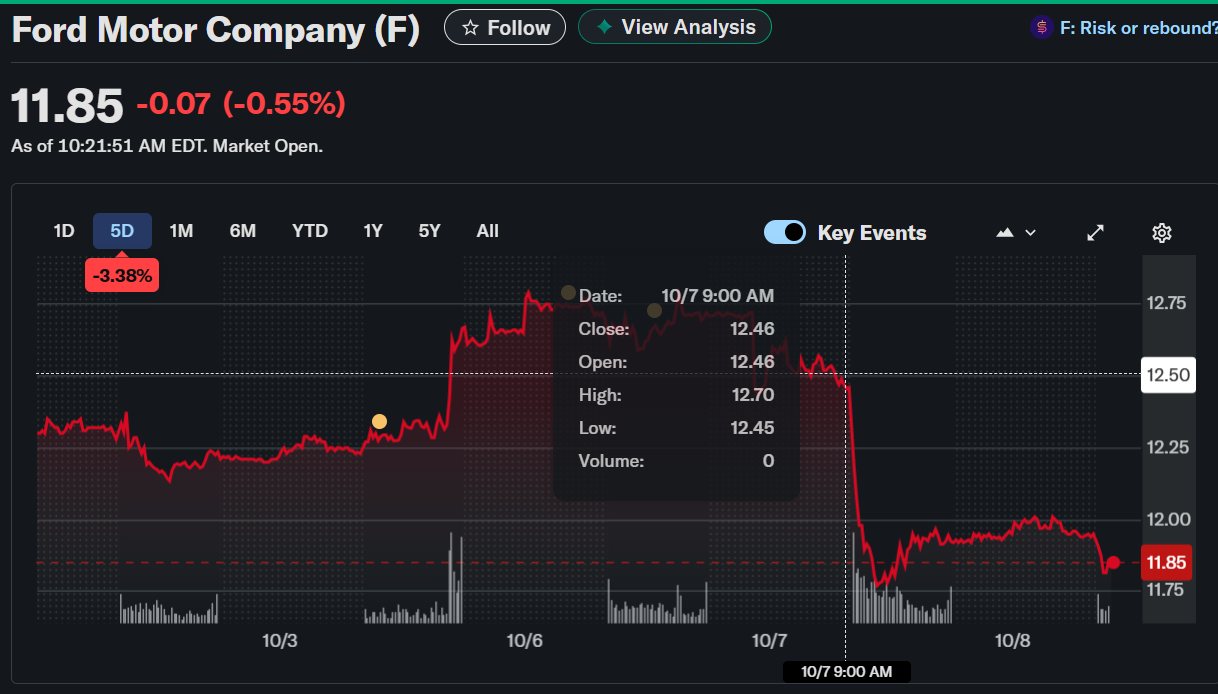TLDR
- Ford ($F) stock closed at $11.92, down 6.14% on October 7, 2025.
- Tcfg Wealth Management cut its Ford holdings by 85.4% in Q2.
- Institutional ownership stands at 58.74%, with several new small investors entering.
- Ford reported Q2 EPS of $0.37, beating estimates, with revenue up 5% YoY.
- Dividend yield remains strong at 5.0%, supported by steady cash flow.
At $11.92, down 6.14% at the close on October 7, 2025, Ford Motor Company (NYSE: F) shares declined sharply after Tcfg Wealth Management LLC disclosed an 85.4% reduction in its holdings during the second quarter.

The institutional investor now owns 23,830 shares, down from 163,054, valued at about $259,000 as of the latest SEC filing.
Institutional Shifts and Market Reaction
The move comes as some institutional investors rebalanced exposure amid cost and production headwinds across the auto sector. Despite the sale by Tcfg Wealth Management, other firms such as Grove Bank & Trust, Elite Financial Inc., and Olde Wealth Management LLC initiated or increased positions in Ford during the first quarter, suggesting a mix of short-term caution and long-term accumulation.
Institutional investors collectively own 58.74% of Ford’s shares, signaling continued confidence in the automaker’s fundamentals despite short-term volatility.
Earnings and Financial Performance
Ford last reported earnings on July 30, 2025, posting $0.37 per share, topping the consensus estimate of $0.33. Quarterly revenue reached $50.18 billion, up 5% year-over-year, surpassing analyst expectations of $42.91 billion.
The company recorded a 12.46% return on equity and a 1.70% net margin, reflecting solid top-line growth amid industry cost pressures. Compared to last year’s $0.47 EPS, profitability remains steady despite rising expenses tied to supply chain challenges and warranty provisions. Analysts expect Ford to post $1.47 EPS for the current fiscal year.
Dividend and Valuation Metrics
Ford maintains a stable dividend policy. The most recent $0.15 quarterly dividend was paid on September 2, to shareholders of record on August 11. This represents a 5.0% yield on an annualized $0.60 payout, with a payout ratio of 76.92%.
The automaker’s valuation stands at a P/E of 15.29, with a market cap of $47.46 billion, and a debt-to-equity ratio of 2.24. Liquidity remains sufficient, supported by a current ratio of 1.10 and a quick ratio of 0.95.
Market Outlook and Investor Sentiment
While Ford’s revenue growth and dividend appeal remain strong, investor sentiment has weakened due to supply chain pressures, inventory buildup, and rising warranty costs. Options data show heightened bearish hedging, with deep out-of-the-money puts reflecting market caution on near-term performance.
$F (Ford) slides 4.4% as supply issues, rising costs, and a weak profit outlook weigh on sentiment. Despite solid sales, inventory and warranty pressures mount.
Options show stress deep OTM puts above 300% IV and steep skew highlight heavy hedging and rising downside caution. pic.twitter.com/EubMIziho7
— Menthor Q (@MenthorQpro) October 7, 2025
Performance metrics indicate mixed returns: 27.85% YTD, 22.30% 1-year, 23.94% 3-year, and an impressive 114.81% 5-year gain, outpacing the S&P 500’s 96.37% over five years.
Despite near-term challenges, Ford’s long-term trajectory in EV expansion, disciplined capital allocation, and stable dividends position it as a resilient player in a rapidly evolving automotive landscape.






